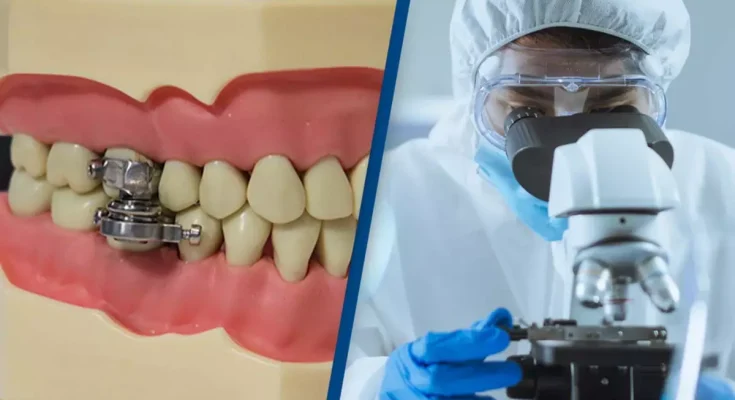Social media users have likened it to a ‘medieval torture device’
Scientists have caused controversy after inventing a ‘weight-loss device’ that people are calling a ‘medieval torture device.’
From dangerous diets to popping pills, the weight loss industry is full of controversial methods.
Most recently, prescription drug Ozempic has taken Hollywood by storm due to its appetite-curbing abilities that ‘trick the brain’ into thinking you’re full.
However, high demand for the drug for weight loss purposes has lead to shortages, leaving those who use it to treat type 2 diabetes unable to source any.
But no weight-loss method is arguably as controversial as the ‘world’s first weight-loss device’, which sees its user’s jaw locked shut.
Created by researchers from New Zealand’s University of Otago, the DentalSlim Diet Control is made up of magnets that are attached to the bottom and top first molar teeth.
This restricts the jaw from opening more than 2 millimeters wide and forces the user to consume a liquid diet that’s lower in calories.
The device was recently the subject of a study published in Nature’s British Dental Journal.

Scientists have invented a ‘weight-loss’ device that sees the user’s jaw locked shut. (University of Otago)
After being fitted with the DentalSlim for two weeks, seven participants lost an average of 14 pounds each and ‘were motivated to continue with their weight loss journey’.
But people aren’t impressed, with many taking to X (formerly Twitter) to share their outrage.
One person wrote: “And this, kids, is why ethics needs to be taught in science. Good God, I thought medicine was past these kinds of torture devices.”
“90% sure this is in breach of a few health and war crime laws,” a second added.
And another joked: “Have you considered wiring the professors fingers together so they can do less of this?”
Professor Paul Brunton, lead researcher from the University of Otago’s Division of Health Sciences, has since said in a statement: “It is a non-invasive, reversible, economical and attractive alternative to surgical procedures. The fact is, there are no adverse consequences with this device.”

While users lose an average of 14 pounds in two weeks, people are outraged by the weight-loss device. (Getty Stock Images)
And a further statement from the University read: “To clarify, the intention of the device is not intended as a quick or long-term weight-loss tool; rather it is aimed to assist people who need to undergo surgery and who cannot have the surgery until they have lost weight.
“After two or three weeks they can have the magnets disengaged and device removed. They could then have a period with a less restricted diet and then go back into treatment. This would allow for a phased approach to weight loss supported by advice from a dietician.”
If you have been affected by any of the issues in this article and wish to speak to someone, contact National Association of Anorexia Nervosa and Associated Disorders (ANAD). You can reach them on their free hotline at 1(888)-375-7767, which is open Monday-Friday, 9am-9pm CST.
Featured Image Credit: University of Otago / Getty Stock Images



